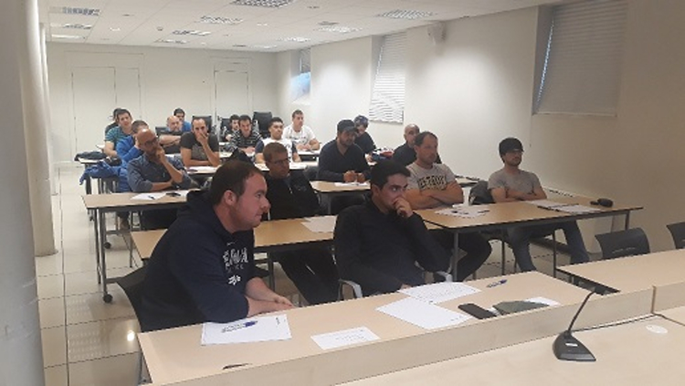This good practice was prepared by Paola Eguinoa Ancho (INTIA).
Introduction to the challenge addressed
The loading, transport and unloading of live animals from the farm to the slaughterhouse involves several potential stressors that can affect animal welfare negatively and the final quality of the product. Trained transporters are key to minimizing stress during these operations.
Every year, INTIA holds a training session on the handling of cattle during transport for a duration of 3 hours, which is attended by 20-30 transporters.
Description of good practice
Training sessions are given by technical specialists from INTIA to animal transporters, with the aim of transferring good cattle handling practices during loading, transport and unloading of animals.
The course addresses practical ideas to avoid typical handling errors caused by ignorance of the handler or fear of the animals. The basic behavioural characteristics of cattle as a herd animal, e.g. fleeing from predators, highly developed senses etc., are explained in depth. The focus is on the elimination of preconceptions and the most frequent mistakes made when handling animals: i.e. hounding animals, penning of animals, squeezing animals preventing them to escape, leaving animals isolated or attacking them. The senses of bovines are explained, how they perceive their environment and therefore how we have to relate to the animals in an appropriate way, (e.g. touching animals without hesitation, approaching animals from the front calmly and smoothly, avoiding abrupt gestures, avoiding rapid changes of light and shaded areas on the ground, as well as bright colours).
The course also deals with general guidelines for loading and unloading animals, i.e. act calmly and avoid shouting, avoid changes in light and noise, wear appropriate dark-coloured clothing, keep the number of people to a minimum, handle animals in groups, avoid sloping downhill surfaces, load in a different place from animal housing, eliminate obstacles and possible places of escape. During loading, it is important not to mix batches of animals, avoid mixing males and females, do not load females in heat, and use clean, non-slip ramps without holes or cracks. It is also recommended that the farmer is present as his or her scent possibly calms the animals. The loading bay should have a passageway parallel to the chute for the farmer to lead the animals. Furthermore, animals should be loaded in groups, approaching the lorry diagonally to the entrance of the loading bay. The lorry must be in good condition, clean and disinfected, the floor must be made of non-slip material. Additionally, there must be movable barriers to separate the animals as well as openings in the body of the lorry to ensure proper ventilation. Water must be available for all the animals at all times. During unloading animals are usually more uneasy due to an unfamiliar environment, it is therefore recommended to pre-plan the arrival at the slaughterhouse to avoid unnecessary delays and to be able to act quickly, with an unloading ramp with a gradient of less than 20%. Finally, the proper use of electric probes and tethering in exceptional situations are explained.


The biggest challenge in implementing this good practice is the availability of adequate installations (chutes, ramps, lorries etc.). The main success factor is the involvement of the transporters, treating the cattle as their own.
Lessons learned: Animals must be treated according to their nature, so understanding the basic features of their behaviour and perception of their environment is key. Trained transporters and appropriate facilities are essential to ensure the welfare of the animals. Stress-free handling of cattle facilitates loading, transport and unloading, ensures the safety of the operators, avoids breakage of facilities, reduces the risk of injury and loss of meat quality.
Impacts
Socio-economic resilience: Transporters trained in the handling of livestock carry out the loading, transport and unloading tasks in a more agile way, in less time. In addition, carrying out these procedures by trained handlers avoids the breakage of installations, reduces the risk of injury and the loss of meat quality.
Animal health and welfare: Improves animal welfare during transport as well as reductions of associated injuries.
Production efficiency and meat quality: Avoids impacts on meat quality: PSE and DFD meat.
Farmer comment
The course is, in general, very satisfactory for participants. It is very practical and ready for implementation. Many of the transporters are also farmers; the concepts explained are also useful for improving livestock handling on farms.
Further information
Animal Transport Guidelines Project.
Materials: http://www.animaltransportguides.eu/materials/
Video: https://www.youtube.com/watch?v=YWQIW2VSPyU